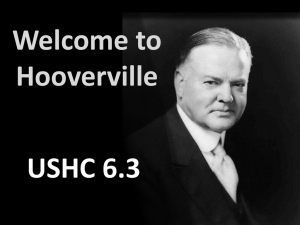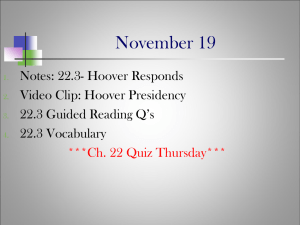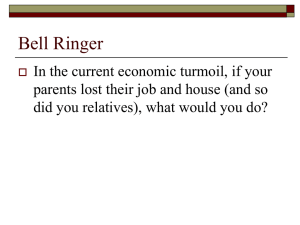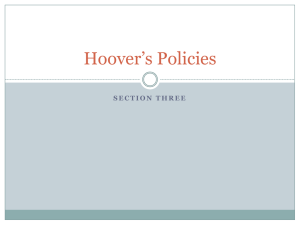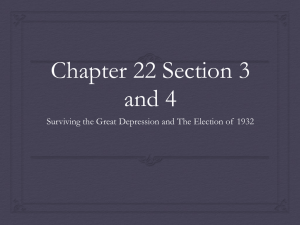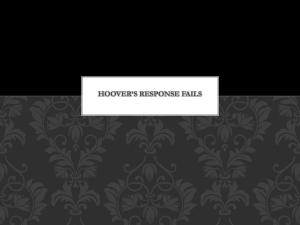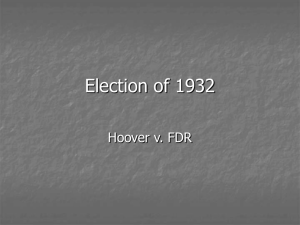The Role of Herbert Hoover
advertisement
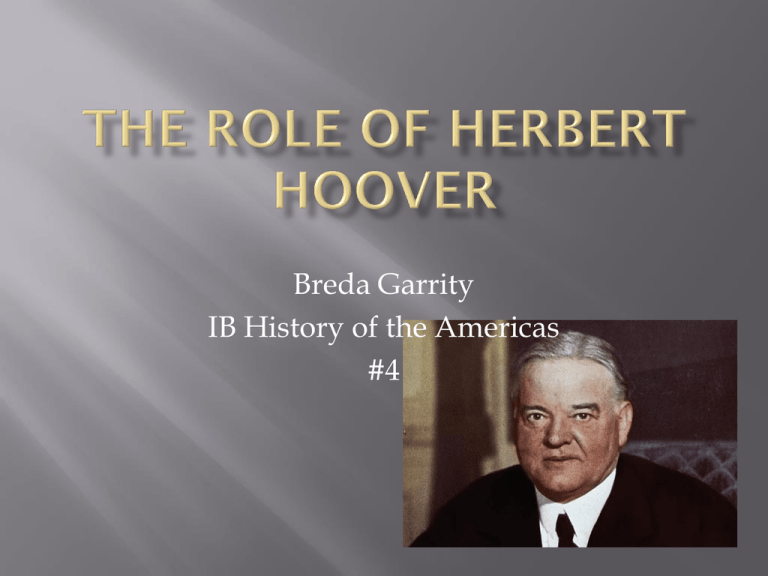
Breda Garrity IB History of the Americas #4 Born on August 10th, 1874. Hoover was one of three children in his family. When he was six his father died of heart problems and when he was nine his mother died of pneumonia. When his mother died the children were separated to live with different relatives. Hoover was sent to live with his uncle in Oregon where he studied at Quaker schools as per the religious beliefs of his family. He went on to study at Stanford where he was part of the first class when it opened in 1891. There he received his diploma in engineering. Herbert Hoover was a brilliant man. He launched a career as a mining engineer. He traveled all over the world to find valuable mineral deposits and establish business enterprises to extract resources. This business made him a millionaire. At the start of WWI Hoover dedicated his talents to humanitarian efforts. Problems for Americans who wanted to get home: Traveler’s checks were not being recognized. Did not have enough money to get home. Solution Hoover came up with was an “American Committee”. They made loans and cashed checks when needed. In the end they sent 12,000 Americans home with a sole debt of $300. After Belgium was invaded by Germany they experienced a massive food shortage- only 25% of their needs were being met. The Ambassador of Belgium contacted Hoover to help. Thus creating the Committee for Relief in Belgium The task was to get food from abroad and ship it to Belgium Hoover arranged the terms by which this food was imported. In the end 11.4 billion pounds of food was shipped to 9.5 million civilians of the war. When the United States joined the war, President Woodrow Wilson asked Hoover to return to the U.S. to serve as wartime food administrator. The Food Administration was created August 10, 1917 directed by Herbert Hoover. He encouraged Americans to reduce their consumption of commodities such as meats so as to send more overseas. After the war, under the direction of Hoover, it became the American Relief Administration. This was an American relief mission which spread throughout Europe and later, Post-Revolutionary Russia The American Relief Administration delivered over 4 million tons of relief supplies to 23 war-torn European countries. For his relief efforts in the war, Hoover became an advisor to President Woodrow Wilson. He then made Hoover a part of the American Delegation to the conference of the Treaty of Versailles. Hoover then served as secretary of commerce for 7 years under President Harding and President Coolidge. Hoover believed in a limited role for government or in other words “laissez-faire”. He was worried that too much government intervention posed a threat to capitalism and individualism. He felt that assistance should be handled on a local, voluntary basis. This can be seen in how Hoover vetoed several bills after the Crash of 1929 that would have provided direct relief to struggling Americans. Hoover became the Republican Party nominee for the election of 1928 He beat his opponent, Albert E. Smith by an overwhelming majority of electoral votes: Hoover 444 to Smith 87. During these first few months Hoover was very active. He worked to improve conditions for Native Americans on government reservations. Won passage of the Boulder Canyon Project Act which led to the construction of the dam on the Colorado Riverlater to be named the Hoover Dam. Placed nearly 2 million acres of federal land in the national forest reserve. Along with these, there were two additional problems Hoover made a point to focus on: Improving the economic health of the nation's agricultural sector. Tariff reform. October 24, 1929, seven months into Herbert Hoover’s presidency, the stock market crashed. Stock prices dropped drastically. This was due to excessive speculation in the stock market. Tuesday October 29, Black Tuesday, the stock market collapsed completely. By mid-November the values of shares on the New York stock exchange had declined 40% This made for a loss of $26 Billion dollars! The Depression's impact on the economy Banks in operation Prime interest rate Volume of stocks sold (NYSE) Privately earned income Personal and corporate savings 1929 1933 25,568 5.03% 1.1 B $45.5B $15.3B 14,771 0.63% 0.65 B $23.9B $2.3B President Hoover was blamed for the stock market crash. However, Hoover had in fact warned President Coolidge in 1925 about the dangers of excessive stock market speculation. He again brought this concern to attention when he was running for presidency in 1928. By 1933 Nearly half of America's banks had failed Unemployment was approaching 15 million people, or 30 percent of the workforce. Nationwide unemployment rates rose from 3 percent in 1929 to 23 percent in 1932. After the crash some of the actions Hoover took were that he: Ordered federal departments to speed up construction projects. Cut $160 million in taxes. Doubled the amount spent on public works. As the Depression set in, there were more demands for government intervention and spending. However, Hoover refused to involve the federal government in forcing fixed prices, controlling businesses, or manipulating the value of the currency- all of which he felt were steps towards socialism. Hoover was largely criticized for refusing to approve large-scale relief programs that might have helped to alleviate the nation's suffering and hunger. His unwillingness to use federal dollars to stimulate the nation's economy, and his failure to recognize the all-encompassing nature of the Great Depression was taken as indifferent to the suffering of Americans. Purpose- To show people how bad of a president Hoover was. It was to show its readers that he was keeping these people’s well-deserved money from them. Origin- May of 1932 in front of the White House. Value- It informed readers of this huge problem and what these Bonus March Men were doing about it. Limitation- It does not fully express the measures Hoover may have initially taken to help the Veterans and does not completely show the aftermath of the Bonus March. Staged by WWI veterans in December of 1932. Several years prior, the Soldier’s Bonus Act was passed by Congress to grant veterans Adjusted Compensation Certificates payable in 1945. Because of the Great Depression and millions out of jobs, the veterans converged on the capitol to urge for early redemption of the certificates. The “Bonus Army” started with around 1,000 men and within a week it grew to 17,000. June 15, 1932, The House of Representatives passed the Patman Bonus Bill which would grant $2.4 billion to be used for the veteran’s bonus. However, it was immediately stopped in the Senate After Congress adjourned the only compensation offered was to pay for the veteran’s transportation home. Many took this offer, but thousands remained to protest. “Prosperity cannot be restored by raids upon the public Treasury” ~President Hoover, 1930 State of the Union Address. Hoover ordered military force to remove the protestors who remained. Too much force was used- tanks, tear gas, and cavalry were brought in to force the Bonus Army out of the city- this display, ordered by Hoover, although not to that extent, even further disgusted Americans. As they walked down Pennsylvania Avenue the Bonus Army sang: Mellon pulled the whistle, Hoover rang the bell, Wall Street gave the signal And the country went to hell. This was an act sponsored by Senator Reed Smoot and Representative Willis C. Hawley and signed into law on June 17, 1930, that raised U.S. tariffs on over 20,000 imported goods to record levels. When campaigning for president during 1928, one of Herbert Hoover's promises to help beleaguered farmers had been to increase tariffs of agricultural products. If there was ever a chance that Hoover would be re-elected in the 1932 election, it was completely diminished after the Bonus March of 1932. It was a clear victory for Roosevelt- only 6 states voted for Hoover. He was the most disliked of all Presidents in history. He was blamed for the Stock Market Crash in 1929. The Great Depression and its longevity was also seen as his fault, especially by the Democratic Party. A "Hooverville" is the popular name for shanty towns built by homeless people during the Great Depression Most large cities built municipal lodging houses for them, but the depression increased this. The homeless clustered in shanty towns close to free soup kitchens. These settlements were often formed on empty land and generally consisted of tents and small shacks. Authorities did not officially recognize these Hoovervilles and occasionally removed the occupants for trespassing on private lands, but they were frequently tolerated or ignored out of necessity. They blamed President Hoover for this, and named the town after him. Democrats coined other terms, such as: "Hoover blanket“- old newspaper used as blanketing. "Hoover flag“- an empty pocket turned inside out. "Hoover leather" - cardboard used to line a shoe when the sole wore through. "Hoover wagon“- an automobile with horses hitched to it because the owner could not afford fuel. In Canada, these were known as Bennett buggies, after the Prime Minister at the time. After 1940 the economy recovered, unemployment fell, and shanty eradication programs destroyed all the Hoovervilles. http://www.youtube.com/watch?v=x3IoHsxqAa8 President Harry Truman invited Hoover to the White House, where he was asked to organize European war relief after World War II. In 1946 Hoover In 1947, President Truman appointed Hoover the chairman of the Commission on Organization of the Executive Branch of the Government. Traveled to 38 countries, Documented food needs, Located surpluses, and Arranged food shipments to countries in need. It was Hoover’s job to cut government waste and improve efficiency. Also, in 1947, was when the Colorado River Dam was renamed the “Hoover Dam”. Beginning in the 1970s, Hoover's reputation began to improve. However, most now argue that Hoover, in reality, could have done little to prevent or solve the Depression. Herbert Hoover died at the age of 90 on October 20, 1964. "Bonus Army March in Washington." Bonus Army March in Washington. N.p., n.d. Web. 04 Feb. 2014. "Herbert Hoover on the Great Depression and New Deal, 1931– 1933." The Gilder Lehrman Institute of American History. N.p., n.d. Web. 03 Feb. 2014. "Herbert Hoover." History.com. A&E Television Networks, n.d. Web. 03 Feb. 2014. "Hoovervilles." History.com. A&E Television Networks, n.d. Web. 02 Feb. 2014. "Stock Market Crash of 1929." Stock Market Crash of 1929. N.p., n.d. Web. 04 Feb. 2014. "The Ludwig Von Mises Institute." Prelude to Depression: Mr. Hoover and Laissez-Faire. N.p., n.d. Web. 04 Feb. 2014. N.p.. Web. 1 Feb 2014. <http://millercenter.org/president/hoover/essays/biography/4 >.

